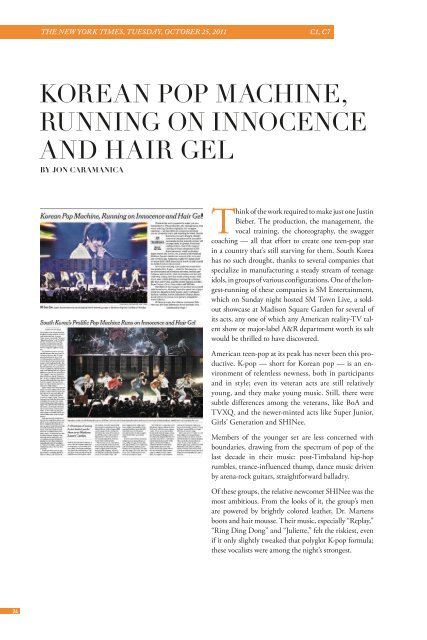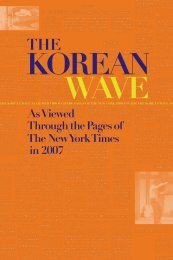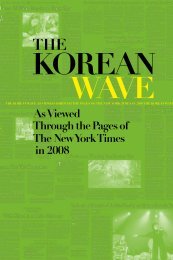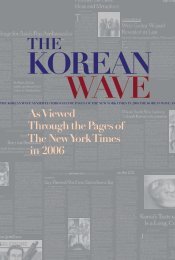The Korean Wave 2010-2011 - Korean Cultural Service
The Korean Wave 2010-2011 - Korean Cultural Service
The Korean Wave 2010-2011 - Korean Cultural Service
You also want an ePaper? Increase the reach of your titles
YUMPU automatically turns print PDFs into web optimized ePapers that Google loves.
<strong>The</strong> New York Times, Tuesday, October 25, <strong>2011</strong>C1, C7<strong>Korean</strong> Pop Machine,Running on Innocenceand Hair GelBy JON CARAMANICAThink of the work required to make just one JustinBieber. <strong>The</strong> production, the management, thevocal training, the choreography, the swaggercoaching — all that effort to create one teen-pop starin a country that’s still starving for them. South Koreahas no such drought, thanks to several companies thatspecialize in manufacturing a steady stream of teenageidols, in groups of various configurations. One of the longest-runningof these companies is SM Entertainment,which on Sunday night hosted SM Town Live, a soldoutshowcase at Madison Square Garden for several ofits acts, any one of which any American reality-TV talentshow or major-label A&R department worth its saltwould be thrilled to have discovered.American teen-pop at its peak has never been this productive.K-pop — short for <strong>Korean</strong> pop — is an environmentof relentless newness, both in participantsand in style; even its veteran acts are still relativelyyoung, and they make young music. Still, there weresubtle differences among the veterans, like BoA andTVXQ, and the newer-minted acts like Super Junior,Girls’ Generation and SHINee.Members of the younger set are less concerned withboundaries, drawing from the spectrum of pop of thelast decade in their music: post-Timbaland hip-hoprumbles, trance-influenced thump, dance music drivenby arena-rock guitars, straightforward balladry.Of these groups, the relative newcomer SHINee was themost ambitious. From the looks of it, the group’s menare powered by brightly colored leather, Dr. Martensboots and hair mousse. <strong>The</strong>ir music, especially “Replay,”“Ring Ding Dong” and “Juliette,” felt the riskiest, evenif it only slightly tweaked that polyglot K-pop formula;these vocalists were among the night’s strongest.But SHINee came in a recognizable format, thesame size as American groups like ’N Sync andthe Backstreet Boys. But what K-pop has excelledat in recent years are large groups that seem to defy logicand order. Super Junior, which at its maximum has 13members, was one of this show’s highlights, appearingseveral times throughout the night in different coloroutfits, shining on “Mr. Simple” and the intense industrialdance-pop of “Bonamana.” (K.R.Y., a sub-group ofSuper Junior, delivered what may have been the night’sbest performance on “Sorry Sorry Answer,” a muscularR&B ballad.)Super Junior was complemented by the nine-womanGirls’ Generation, which offered a more polite take onK-pop, including on “<strong>The</strong> Boys,” which is its debutAmerican single. Girls’ Generation gave perhaps thebest representation of K-pop’s coy, shiny values in keepingwith a chaste night that satisfied demand, but notdesire. (It was an inversion on the traditional Americanformula; in this country young female singers are oftenmore sexualized than their male counterparts.)Male and female performers shared the stage here onlya couple of times, rarely getting even in the ballpark ofinnuendo. In one set piece two lovers serenaded eachother from across the stage, with microphones theyfound in a mailbox (he) and a purse (she). In betweenacts the screens showed virginal commercials aboutfriendship and commitment to performance; duringthe sets they displayed fantastically colored graphics,sometimes childlike, sometimes Warholian, but neverless than cheerful.In the past few years K-pop has shown a creeping globalinfluence. Many acts release albums in <strong>Korean</strong> andJapanese, a nod to the increasing fungibility of Asianpop. And inroads, however slight, are being made intothe American marketplace. <strong>The</strong> acts here sang and lipsynced in both <strong>Korean</strong> and English. Girls’ Generationrecently signed with Interscope to release music in theUnited States. And in August Billboard inaugurated aK-Pop Hot 100 chart. But none of the acts on the SMTown Live bill are in the Top 20 of the current editionof the fast-moving chart. This is a scene that breedsquickly.Which means that some ideas that cycle in may sooncycle out. That would be advisable for some of the songsaugmented with deeply goofy rapping: showing theEnglish translation of the lyrics on screen didn’t help.<strong>The</strong> best rapping of the night came from Amber, thetomboy of the least polished group on the bill, f(x), whoreceived frenzied screams each time she stepped out infront of her girly bandmates.If there was a direct American influence to be gleanedhere, it was, oddly enough, Kesha who best approximatesthe exuberant and sometimes careless genrelessnessof K-pop in her own music; her songs “Tik Tok”and “My First Kiss” (with 3OH!3) were covered duringthis show.But while she is simpatico with the newer K-pop modes,she had little to do with the more mature styles. Thosewere represented by the Josh Groban-esque crooning ofKangta, lead singer of the foundational, long-disbanded<strong>Korean</strong> boy band H.O.T., who made a brief appearanceearly in the night, and the duo TVXQ, a slimmed-downversion of the long-running group by that name, whoat one point delved into an R&B slow jam reminiscentof Jodeci or early Usher. BoA, the night’s only featuredsolo artist, has been making albums for a decade, andher “Copy & Paste” sounded like a vintage 1993 JanetJackson song.She’ll also star in “Cobu,” a 3-D dance film to be releasednext year, previews of which induced shrieks beforethe concert began. <strong>The</strong> crowd also screamed at anad for Super Junior Shake, an iPhone game app, and forthe SM Entertainment global auditions, which will takeplace early next year in several countries, and will keepthe machine oiled for years to come.24Copyright © <strong>2011</strong> by <strong>The</strong> New York Times Co. Reprinted with permission.25





